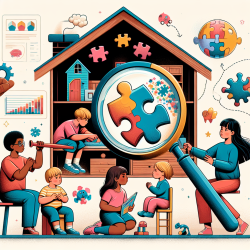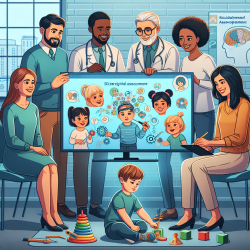Introduction
In the realm of speech-language pathology, community engagement plays a pivotal role in enriching therapeutic practices and outcomes. A recent study titled "Library services enriching community engagement for dementia care: The Tales & Travels Program at a Canadian Public Library as a case study" offers insightful findings that can be translated into speech therapy practices, particularly in creating inclusive and engaging environments for children.
Understanding the Study
The study focuses on a storytelling and social program designed for individuals with dementia, conducted at a Canadian public library. It explores how public library programs can contribute to community-based dementia care and identifies the strengths and challenges of running such programs. Through participant observations and interviews, the study highlights the importance of inclusive platforms that foster engagement, support relationships, and extend accessible services.
Key Takeaways for Speech Therapy Practitioners
1. Inclusive Environments Foster Engagement
The library program's success in creating a welcoming and familiar environment can be mirrored in speech therapy settings. By designing therapy spaces that are comfortable and familiar, practitioners can enhance engagement and participation among children. This can be achieved by incorporating elements that children are accustomed to, such as favorite books, familiar toys, and sensory materials.
2. Collaboration with Community Resources
The collaboration between the library and the Alzheimer Society exemplifies the power of partnerships in extending the reach and impact of programs. Speech therapists can benefit from collaborating with local libraries, schools, and community organizations to create multidisciplinary programs that support children's communication needs. These partnerships can provide additional resources and perspectives, enriching the therapeutic process.
3. Person-Centered Approaches
The study emphasizes the importance of person-centered care, which can be directly applied to speech therapy. Tailoring interventions to meet the unique needs and preferences of each child ensures that therapy is relevant and engaging. Practitioners should consider the child's interests, cultural background, and personal experiences when designing therapy activities.
4. Use of Storytelling and Multisensory Activities
The Tales & Travels program utilizes storytelling and multisensory experiences to engage participants. Speech therapists can incorporate similar techniques by using stories, music, and sensory activities to enhance language development and communication skills. These activities can stimulate different senses and provide a rich context for language learning.
Encouraging Further Research and Practice
The findings from this study highlight the potential for libraries and community programs to support speech therapy practices. Practitioners are encouraged to explore further research on community-based interventions and consider how these findings can be integrated into their work. By staying informed and open to new approaches, speech therapists can continue to improve outcomes for children.
To read the original research paper, please follow this link: Library services enriching community engagement for dementia care: The Tales & Travels Program at a Canadian Public Library as a case study.










